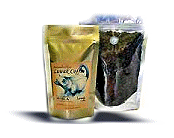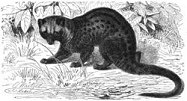I’ve read positive reviews and negative thoughts on Luwak coffee. I’ve always been one that has to know first hand and though I have not yet had the pleasure or unfortunate experience to taste this unique brew, I look forward to my sampling. I can tell you one thing for sure before I ever take my first sip, good or bad, it will always be a crappy cup of coffee. For those of you who are not aware of the harvesting process of Kopi Luwak, read on….
 You can buy Luwak Coffee by visiting animalcoffee.com The pouch image to your right is one example of how they package it. I’ll show you the fancy schmancy packaging they have later on.
You can buy Luwak Coffee by visiting animalcoffee.com The pouch image to your right is one example of how they package it. I’ll show you the fancy schmancy packaging they have later on.
So how does one manage to harvest themselves some Luwak Coffee? Well, you could grow the beans yourself as they use Arabica and Robusta beans but that isn’t all there is to it. First you must have yourself a Luwak. What in the hell is that? I’ll tell you. It is an Asian Palm Civet. A cat-like animal common to many south east Asian countries.. See image below.
 If you want to have a cup of Luwak Coffee, you must first pick up the feces of the Palm Civet. Ewwww! I know, sounds stinky and nasty doesn’t it? I suggest that it is not.
If you want to have a cup of Luwak Coffee, you must first pick up the feces of the Palm Civet. Ewwww! I know, sounds stinky and nasty doesn’t it? I suggest that it is not.
The Luwak is picky. It chooses ripe coffee cherries and eats them as a part of their diet. They do not every cherry they find. I am assuming they eat only the best ones they find. Well, as we all know, whatever goes in, must come out sooner or later. Once digested and the cherry flesh has been removed, it comes on out the exit zone, or whatever else you may call it. *winks* That is when the beans (in clumps sort of resembling grapes) are collected and roasted for distribution as Luwak Coffee.
 This is an example of the Civet processed beans. Yum, (cough) yum. Sort of looks like…. candy? I doubt that. Most coffee berry flesh is removed by mechanical means. You can not get more natural than this.
This is an example of the Civet processed beans. Yum, (cough) yum. Sort of looks like…. candy? I doubt that. Most coffee berry flesh is removed by mechanical means. You can not get more natural than this.
Luwak can not be farmed for the sole intention of harvesting their coffee bean poopies. All beans are collected in the wild. I’d sure hate to be the one running around looking for a Luwak pile. But they do and their efforts are rewarded with a rich, exclusively rare, coffee bean.
I wanted to include this note from the animalcoffee (dot) com site:
Virtually all the Luwak Coffee ® from Java and Bali is Robusta however the Deluxe Gift Boxes available on this site feature Arabica Luwak Coffee from the Mandheling region in Sumatra, where even “regular” coffee is good. Sounds delicious!
Luwak coffee does not have a smell until it is roasted. Imagine that! I would think it would but they indicate that it does not. I look forward to a sampling of this intriguing coffee bean. So do my women’s group. I have a group of pals who enjoy cupping with me.
Last words: Wondering how much this brew will cost you? Well, it does not come cheap. Kopi Luwak will run you $400 a pound. ACK! Don’t run away scared now, you can get Budget Kopi Luwak at US$50 per pound but I’m afraid that I don’t like the idea of that. Makes me wonder if it would be ‘sub-standard’. But you can get 2 ounce packets for the modest sum of $25-$35. Ouch, I know. But I think worth it to be able to say you’ve tried it if for no other reason. Note: The reason for the expensive price tag is less than 300 kilograms available each year at an accepted market price of approximately US$1,000 per kilogram (approx. US$400 per pound). The supply is limited and considering all beans are collected from the jungle floor, one can certainly understand.




good afternoon, I am from the islands of the philippines, I heard that civet coffee are only found in Indonesia. It is bad to hear that, because here in our island, people loves to drink this kind of coffee. I am willing to help the industry of this product to have more supplies. Thank you very much………..
There are no words to derscbie how bodacious this is.